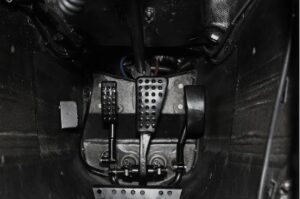Formula 1 isn’t just about fast cars and daring drivers; it’s a high-stakes lab where genius engineers constantly push the rules. The catch? The moment someone cooks up something too good, the rulebook often slams shut. It’s a wild cycle: innovate, dominate, get banned. All to keep the racing close and the skill real.
Let’s look back at some legendary inventions that changed the game… right before they got outlawed:
The Shark Fin (2006)
Renault stuck this tall, vertical fin on the engine cover. It worked amazingly well, stabilizing the car in crosswinds and feeding clean air to the rear wing. Soon, everyone copied it. But then the complaints rolled in: “It looks ugly!” “Ruins the car’s lines!” McLaren, especially, wasn’t having it. A classic F1 clash: pure speed vs. pure looks. Looks won… eventually.
McLaren’s Secret Brake Trick (1997)
Imagine braking each back wheel independently mid-corner. That’s what McLaren did. It gave drivers laser-precision turning, killing understeer and shaving seconds. Rivals cried foul, claiming it was basically illegal four-wheel steering. Turns out, being too clever can backfire fast.

Tyrrell’s Bonkers Six-Wheeler (1976)
Four tiny front wheels! The P34 looked like something from a sci-fi movie, but it worked. More front grip, less drag. Jody Scheckter even won a race in it! But keeping four front tires happy? A logistical nightmare. Sometimes, even brilliant ideas are just too weird to last.
The “X-Wings” (Late 90s)
Tyrrell (again!) stuck tall winglets on the car’s sides for extra downforce. Ferrari and Sauber quickly copied the trick. Problem? These things were dangerous. Drivers couldn’t see past them, and if they snapped off in a crash? Flying debris. Safety concerns trumped the speed boost, and they were gone in a flash.
Brabham’s “Fan Car” (1978)
This one’s legendary. The Brabham BT46B had a giant fan at the back, sucking the car onto the track with insane downforce. Officially, it was for “cooling.” Yeah, right. Niki Lauda obliterated the field in its only race. Rivals were so furious, it got banned before the next Grand Prix even started. Perfected ground effect? Too perfect, apparently.
Williams’ Mind-Reading Suspension (Early 90s)
Computers constantly tweaking the suspension for perfect ride height and balance? Williams nailed it, dominating championships. But the FIA decided it took too much skill out of the driver’s hands. Banned in ’94, forcing drivers to actually feel the bumps again. Ouch.
Traction Control (On-again-off-again)
This electronic babysitter stopped wheels from spinning wildly, letting drivers stomp the throttle earlier, especially in the wet. Faster? Sure. More exciting? Not really. Banned multiple times (most recently in 2008) to keep those dramatic power slides and car control skills front and center. Driver talent > computer chips.
The Standard Brain (2008)
Teams used to build their own super-secret Electronic Control Units (ECUs – the car’s brain). This let some hide illegal driver aids in the software! To stop the spy-vs-spy tech war, the FIA made everyone use the same standard ECU (supplied by McLaren, ironically). Now, the competition had to be out in the open: design, aero, and driver skill.
Rocket Fuel (Turbo Era)
Back in the wild turbo days, teams brewed up insane, toxic fuel cocktails (think toluene, benzene) for insane qualifying power boosts. These potions were nasty and pushed engines to the breaking point. The FIA finally reined it in for safety and fairness, bringing F1 fuel closer to what you might actually pump at a gas station (well, kinda).
Why This Matters: These banned wonders show F1 at its best: insanely clever, fiercely competitive, and always evolving. They pushed boundaries, forced rule changes, and sometimes even made the sport safer. They remind us that F1’s magic lies in that constant dance between genius innovation and the need for a fair, thrilling fight where the driver truly matters. The next “too clever” idea is probably already being sketched in a wind tunnel somewhere… just waiting for its moment (and inevitable ban)!





